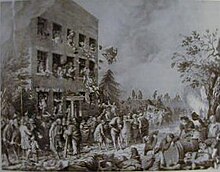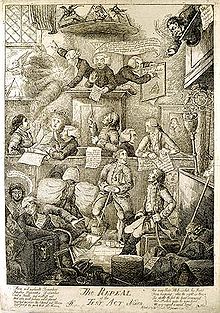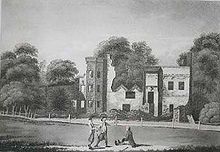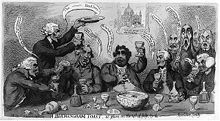Priestley Riots

The Priestley Riots took place from 14 to 17 July 1791 in Birmingham, England; their main targets were religious Dissenters, most notably the religious and political controversialist, Joseph Priestley. Driven by anger over the Dissenters' attempts to gain full civil rights and their support of the French revolution, the rioters attacked or burned four Dissenting chapels, twenty-seven houses and several businesses. While the riots were not initiated by William Pitt's administration, the national government was slow to respond to the Dissenters' pleas for help and overjoyed at their plight. Local Birmingham officials seem to have been involved in the planning of the riots and were reluctant to prosecute any ringleaders after they ended.
Historical context

Birmingham was a city notorious for its riots. In 1714 and 1715 the townspeople attacked Dissenters during the trial of Henry Sacheverell and in 1751 and 1759 Quakers and Methodists felt the crowd's wrath. During the Gordon Riots in 1780, large crowds assembled in Birmingham but did not cause the level of destruction as those in London. In 1766, 1782, 1795 and 1800 mobs protested high food prices.[1] One contemporary described Birmingham rioters as the "bunting, beggarly, brass-making, brazen-faced, brazen-hearted, blackguard, bustling, booby Birmingham mob."[2]
Before the late 1780s, the elite of Birmingham, whether Dissenter or Anglican, had lived in solidarity: they were on the same town promotional committees; they pursued joint scientific interests through the Lunar Society; and they worked together in local government. They stood united against unruly plebeians, who they viewed as a threat.[3] Yet Priestley in his An Appeal to the Public on the Subject of the Birmingham Riots (1791), written after the riots, argued that this cooperation was not as amicable as generally believed, revealing that disputes over the local library, Sunday schools, and church attendance had divided the Dissenters and the Anglicans.[4]
Once Birmingham Dissenters started to agitate for the repeal of the Test and Corporation Acts, which restricted Dissenters' civil rights, any semblance of unity among the elite of the town disappeared. Unitarians such as Joseph Priestley were at the forefront of this campaign, making orthodox Anglicans nervous and angry. Beginning in 1787, the formation of separate Dissenting groups for the sole purpose of overturning these laws started a rift in the community.[5] Priestley's support of the repeal and his heterodox religious views, which were widely published, inflamed the populace.[6] In February of 1790, the men representing the Establishment in Birmingham formed their own group to oppose the interests of the Dissenters and to counteract what they felt was the undesirable importation of French revolutionary ideals.[7] One month before the riots, Priestley tried to form a reform society, the Warwickshire Constitutional Society, which would have supported universal suffrage and short Parliaments. Although this society was not realized, the efforts to found it increased the tension in Birmingham.[8]
In addition to these religious and political differences, both the lower-class rioters and the upper-class Anglican leaders had economic complaints against the middle-class Dissenters. They envied the ever-increasing prosperity of these industrialists as well as the power that came with that economic success.[9] Priestley himself had written a pamphlet on how best to extract the most work for the smallest amount of money from the poor: An Account of a Society for encouraging the Industrious Poor (1787). Its emphasis on debt collection did not endear him to the poverty-stricken.[10]
Hints of trouble
On 11 July, a local Birmingham newspaper announced that on 14 July there would be a dinner at the Hotel in Temple Row to celebrate the second anniversary of the storming of the Bastille; the invitation encouraged "any Friend of Freedom" to attend. However, alongside this notice was an obvious threat: "an authentic list" of the participants would be published after the dinner.[11] On the same day, "an ultra-revolutionary" handbill, written by James Hobson (although his authorship was not known at the time), entered circulation. Town officials offered 100 guineas for information regarding the publication of the handbill and its author but learned nothing. The Dissenters were forced to plead ignorance and decry such radicalism.[12] It was clear by 12 July that there would be trouble at the dinner and on the morning of 14 July graffiti such as "destruction to the Presbyterians" and "Church and King for ever" was being scrawled across the town.[13] At this point, Priestley was dissuaded from attending the dinner by his friends, who were fearful of his safety.[14]
July 14

Around 90 hardy sympathizers of the French revolution came to celebrate Bastille Day on the 14th; the banquet was led by James Keir, an Anglican industrialist. When the revelers arrived at the Hotel around 2 or 3 p.m., they were greeted by 60 or 70 protesters who eventually dispersed while yelling, rather bizarrely and confusingly, "no popery."[14] By the time the celebrants ended their dinner, around 7 or 8 p.m., a crowd of hundreds had gathered. The rioters, who "were recruited predominantly from the industrial artisans and labourers of Birmingham,"[15] threw stones at the departing guests and sacked the Hotel.[13] After looting and destroying the Hotel, they moved on the Quaker meeting-house until someone yelled that the Quakers "never trouble themselves with anything, neither on one side nor the other" and were convinced to attack the New Meeting chapel instead, where Priestley presided as minister.[16] They burned the New Meeting chapel to the ground, quickly followed by the Old Meeting, another Dissenting chapel.
The rioters proceeded to Priestley's home, Fairhill. Priestley barely had enough time to evacuate and he and his wife fled from Dissenting friend to friend during the riots. Although his son, William, and others stayed behind to protect his home, they were overcome and it was looted and burned to the ground. Priestley's valuable library, scientific laboratory and manuscripts were all lost in the flames.[14]
July 15, 16 and 17

Although the Earl of Aylesford attempted to quash the mounting violence on the night of the 14th, he and the other magistrates were unable to control the crowd and the mob liberated local prisons on the 15th.[13] Thomas Woodbridge, the Keeper of the Prison, deputized several hundred people to help him quell the mob, but many of these turned out to be rioters themselves.[17] The mob destroyed John Ryland's home, Bakerville House, and drank countless bottles of liquor which they found in the cellar. When the newly appointed constables arrived on the scene, the mob attacked and disarmed them. One man was killed.[18] The local magistrates and law enforcement, such as it was, did nothing further to restrain the mob and did not read the riot act until the military arrived on 17 July.[19]
On the 16th, the homes of Joseph Jukes, John Coates, John Hobson, Thomas Hawkes, and John Harwood, a blind Baptist minister, were all ransacked or burned.[18] The Baptist Meeting at King's Heath, a Dissenting chapel, was also destroyed. William Russell and William Hutton, a historian, stationer and debt collector, both tried to defend their homes, but to no avail—the men they hired refused to fight the mob.[18] When the rioters arrived at John Taylor's home, a justice of the peace, they carefully moved all of the furniture and belongings of its current occupant, the Dowager Lady Carhampton, a relative of George III, out of the house before they burned it.[20] The homes of George Russell, a justice of the peace, Samuel Blyth, one of the ministers of New Meeting, Thomas Lee and a Mr. Westley all came under attack on the 15th and 16th. Samuel Galton bribed the rioters with ale and money—they abandoned their attack on his home.[21]
By 2 p.m. on 16 July, the rioters had left Birmingham and were heading towards King's Norton and the Kingswood Chapel; it was estimated that one group of the rioters totaled 250 to 300 people. They burned Cox's farm at Warstock and looted and attacked the home of a Mr. Taverner. When they reached Kingswood, they burned the Dissenting chapel and the home of the Dissenting minister. By this time, Birmingham had shut down—no business was being conducted.[21]
According to contemporary accounts, the mob's last sustained violent encounter was around 8 p.m. on the 17th; about 30 "hard core" rioters attacked the home of William Withering, an Anglican who attended the Lunar Society frequented by Priestley and Keir. Withering, along with a group of men whom he had hired, managed to fend the rioters off.[22] When the military finally arrived to restore order on the 17th and 18th most of the rioters had disbanded, although there were rumors that mobs were destroying property in Alcester and Bromsgrove.[23]
All in all, four Dissenting churches had been severely damaged or burned down and twenty-seven homes had been attacked, many looted and burned. The mob seemed to focus their attacks first on those who had attended the Bastille celebration on the 14th and then expanded their violence to include Dissenters of all kinds as well as members of the Lunar Society.[24]
Aftermath and trials

Although eventually forced to send troops to Birmingham, George III said "I cannot but feel better pleased that Priestley is the sufferer for the doctrines he and his party have instilled, and that the people see them in their true light."[25] Priestley and other Dissenters blamed the government for the riots, believing that William Pitt and his supporters had instigated them, but it seems from the evidence that the riots were actually organized by local Birmingham officials. The national government forced the local residents to pay restitution to those whose property had been damaged; the total eventually amounted to £23,000.[26]
Some of the rioters acted in an organized fashion and seemed to be led by local officials during the attacks, leading to accusations of premeditation. Several Dissenters discovered that their homes were to be attacked several days before the rioters arrived, leading them to believe that there was a prepared list of victims.[27] This "disciplined nucleus of rioters," which numbered only thirty or so, directed the mob and stayed sober throughout the three to four days of rioting. Unlike the hundreds of others who joined in, they could not be bribed to stop their destructions.[28] If a concerted effort had been made by the elite of Birmingham to attack the Dissenters, it was more than likely the work of Benjamin Spencer, a local minister, Joseph Carles, a justice of the peace and landowner, and John Brooke, an attorney, coroner and under-sheriff.[29] Carles and Spencer made no attempt to stop the rioters, although they were present at the outbreak, and Brooke seems to have led them to the New Meeting chapel. Witnesses at the time agreed "that the magistrates promised the rioters protection so long as they restricted their attacks to the meeting-houses and left persons and property alone."[30] The magistrates also refused to arrest any of the rioters and released any that had been arrested.[31] When instructed by the national government to prosecute the instigators of the riot, these local officials dragged their heels and when finally forced to try the ringleaders, they intimidated witnesses and made a mockery of the entire proceeding.[32] Only seventeen of the fifty rioters who had been charged were ever brought to trial; four were found guilty, one of whom was pardoned. Two were hanged and one was transported to Botany Bay. Priestley and others felt that these men were found guilty not because they were rioters but because "they were infamous characters in other respects."[33]
After the riots Birmingham was, according to James Watt, "divided into two parties who hate one another mortally."[34] Priestley initially wanted to return and deliver a sermon on the Bible verse "Father, forgive them, for they know not what they do," but he was dissuaded by friends who were convinced that it was too dangerous.[35] The riots revealed that the Anglican gentlemen of the town were not averse to using violence against Dissenters who they viewed as potential revolutionaries. They had no qualms, either, about raising a potentially uncontrollable mob.[36] Many of those attacked left Birmingham; as a result, the town became noticeably more conservative after the riots.[36] The remaining supporters of the French revolution decided not to hold a dinner celebrating Bastille Day the following year.[36]
Gallery
In 1792, Joseph Johnson published Views of the Ruins of the Principal Houses Destroyed during the Riots at Birmingham with etchings by William Ellis after P. H. Witton's drawings. These are some of the images that purport to show the destruction caused by the rioters.
- widths="100px"
-
New Meeting chapel
-
Joseph Priestley's home, Fairhill
Notes
- ^ Rose, 70-1; Schofield, 263-4.
- ^ Qtd. in Rose, 70.
- ^ Rose, 70-1.
- ^ Sheps, 50.
- ^ Rose, 71; Sheps, 51-2; Schofield, 269-77.
- ^ Schofield, 268-9.
- ^ Rose, 72; Schofield, 277-283.
- ^ Rose, 72; Schofield, 283.
- ^ Sheps, 47-50; Thompson, E.P. The Making of the English Working Class. New York: Vintage (1966), 73-5.
- ^ Schofield, 266.
- ^ Rose, 72; Schofield, 283-4.
- ^ Rose, 72-3; Sheps, 55-7; Schofield, 283-4.
- ^ a b c Rose, 73.
- ^ a b c Rose, 73; Schofield, 284-5.
- ^ Rose, 83.
- ^ Qtd. in Rose, 73; see also Schofield, 284-5.
- ^ Rose, 73-4.
- ^ a b c Rose, 74.
- ^ Rose, 74; Schofield, 287.
- ^ Rose, 74-5.
- ^ a b Rose, 75.
- ^ Rose, 75-6.
- ^ Rose, 76.
- ^ Rose, 76; Sheps, 46.
- ^ Qtd. in Gibbs, F. W. Joseph Priestley: Adventurer in Science and Champion of Truth. London: Thomas Nelson and Sons (1965), 204.
- ^ Rose, 77-8.
- ^ Rose, 78-9; Schofield, 287.
- ^ Rose, 79.
- ^ Rose, 80; Schofield, 285.
- ^ Rose, 81; see also Schofield, 285.
- ^ Rose 81; Schofield, 285-6.
- ^ Rose, 82; Schofield, 288-9.
- ^ Qtd. in Rose, 82.
- ^ Qtd. in Rose, 83.
- ^ Schofield, 289.
- ^ a b c Rose, 84.
Bibliography
- —. An Authentic Account of the Riots in Birmingham, also . . . the trials of the Rioters. Birmingham: 1791.
- —. Views of the Ruins of the Principal Houses Destroyed during the Riots at Birmingham. London: J. Johnson, 1791.
- Hutton, Catherine. A Narrative of the Riots in Birmingham, July 1791. Birmingham: 1875.
- Maddison, R. E. S. and Francis R. Maddison. "Joseph Priestley and the Birmingham Riots." Notes and Records of the Royal Society of Lond 12 (1957): 98-113.
- Martineau, Dennis. "Playing Detective: The Priestley Riots of 1791." Birmingham Historian 12–13 (1997): 11-18.
- Priestley, Joseph. An Appeal to the Public on the Subject of the Riots in Birmingham. Birmingham: 1791.
- Rose, R. B. "The Priestley Riots of 1791." Past and Present 18 (1960): 68-88.
- Schofield, Robert E. The Enlightened Joseph Priestley: A Study of His Life and Work from 1773 to 1804. University Park: Pennsylvania State University Press, 2004. ISBN 0271024593.
- Sheps, Arthur. "Public Perception of Joseph Priestley, the Birmingham Dissenters, and the Church-and-King Riots of 1791." Eighteenth-Century Life 13.2 (1989): 46-64.
External links
- The Joseph Priestley Society
- www.josephpriestley.com - Comprehensive site which includes a bibliography, links to related sites, images, information on manuscript collections, and other helpful information.


